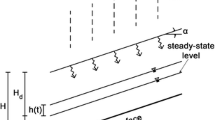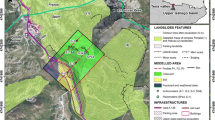Abstract
In the present paper, a finite element approach is proposed to analyse the mobility of active landslides which are controlled by groundwater fluctuations within the slope. These landslides are usually characterised by low displacement rates with deformations that are essentially concentrated within a narrow shear zone above which the unstable soil mass moves with deformations of no great concern. The proposed approach utilises an elasto-viscoplastic constitutive model in conjunction with a Mohr-Coulomb yield function to describe the behaviour of the soil in the shear zone. For the other soils involved by the landslide, an elastic model is used for the sake of simplicity. A significant advantage of the present method lies in the fact that few constitutive parameters are required as input data, the most of which can be readily obtained by conventional geotechnical tests. The rest of the required parameters should be calibrated on the basis of the available monitoring data concerning the change in the piezometric levels and the associated movements of the unstable soil mass. After being calibrated and validated, the proposed approach can be used to predict future landslide movements owing to expected groundwater fluctuations or to assess the effectiveness of drainage systems which are designed to control the landslide mobility. The method is applied to back-predict the observed field behaviour of three active slow-moving landslides documented in the literature.



















Similar content being viewed by others
References
Angeli MG, Gasparetto P, Menotti RM, Pasuto A, Silvano S (1996) A visco-plastic model for slope analysis applied to a mudslide in Cortina d’Ampezzo, Italy. Q J Eng Geol 29(3):233–240
Bertini T, D’Elia B, Grisolia M, Olivero S, Rossi-Doria M (1984) Climatic conditions and slow movements of colluvium covers in central Italy. Proc 4th Int Symp Landslides Toronto 1:367–376
Bertini T, Cugusi F, D’Elia B, Rossi-Doria M (1986) Lenti movimenti di versante nell’Abruzzo adriatico: caratteri e criteri di stabilizzazione. Proc 16th Convegno Nazionale Geotecnica Bologna 1:91–100
Bracegirdle A, Vaughan PR, High DW (1992) Displacement prediction using rate effects on residual shear strength. Proc 6th Int Symp Landslides Christchurch N Z 1:343–348
Calvello M, Cascini L, Sorbino G (2008) A numerical procedure for predicting rainfall-induced movements of active landslides along pre-existing slip surfaces. Int J Numer Anal Methods Geomech 32(4):327–351
Conte E, Troncone A (2008) Soil layer response to pore pressure variations at the boundary. Geotechnique 58(1):37–44
Conte E, Troncone A (2011) An analytical method for predicting the mobility of slow-moving landslides owing to groundwater fluctuations. J Geotech Geoenviron Eng ASCE 137(8):777–784
Conte E, Troncone A (2012a) Stability analysis of infinite clayey slopes subjected to pore pressure changes. Geotechnique 62(1):87–91
Conte E, Troncone A (2012b) Simplified approach for the analysis of rainfall-induced landslides. J Geotech Geoenviron Eng ASCE 138(3):398–406
Conte E, Silvestri F, Troncone A (2010) Stability analysis of slopes in soils with strain-softening behaviour. Comput Geotech 37:710–722
Corominas J, Moya J, Ledesma A, Lloret A, Gili JA (2005) Prediction of ground displacements and velocities from groundwater level changes at the Vallcebre landslide (Eastern Pyrenees, Spain). Lanslides 2(2):83–96
Cruden DM, Varnes DJ (1996) Landslides—investigation and mitigation. Special Report No. 247, Transportation Research Board, National Academy Press, Washington
D’Elia B, Picarelli L, Leroueil S, Vaunat J (1998) Geotechnical characterisation of slope movements in structurally complex clay soils and stiff jointed clays. Riv Ital Geotecnica 32(3):5–32
Desai CS, Samtani NC, Vulliet L (1995) Constitutive modeling and analysis of creeping soils. J Geotech Eng ASCE 121(1):43–56
di Prisco C, Imposimato S (1996) Time dependent mechanical behaviour of loose sands. Mech Cohesive-Frictional Mater 1(1):45–73
di Prisco C, Imposimato S (2002) Static liquefaction of a saturated loose sand stratum. Int J Solids Struct 39:3523–3541
di Prisco C, Imposimato S (2003) Non local numerical analyses of strain localisation in dense sand. Math Comput Model 37(5–6):497–506
Ferrari A, Laloui L, Bonnard C (2008) Case histories: geomechanical modelling of a natural slope affected by multiple slip surface failure mechanism. Intensive Course on Landslide Quantitative Risk Assessment and Risk Management, Barcelona, Spain
Fredlund DG, Rahardjo H (1993) Soil mechanics for unsaturated soils. Wiley, New York
Gottardi G, Butterfield R (2001) Modelling ten years of downhill creep data. Proc 5th Int Conf Soil Mech Geotech Eng Istanbul Turk 1–3:27–31
Herrera G, Fernández-Merodo JA, Mulas J, Pastor M, Luzi G, Monserrat OA (2009) Landslide forecasting model using ground based SAR data: the Portalet case study. Eng Geol 105(3–4):220–230
Laloui L, Ferrari A, Bonnard C (2009) Geomechanical modelling of the Steinernase landslide (Switzerland). Proc 1st Ital Worksh Landslides Napoli 1:186–195
Ledesma A, Corominas J, Gonzàles A, Ferrari A (2009) Modelling slow moving landslides controlled by rainfall. Proc 1st Ital Work Landslides Napoli 1:196–205
Leroueil S, Vaunat J, Picarelli L, Locat J, Faure R, Lee H (1996) A geotechnical characterization of slope movements. Proc 7th Int Symp Landslides Trondheim 1:53–74
Lollino P, Elia G, Cotecchia F, Mitaritonna G (2010) Analysis of landslide reactivation mechanisms in Daunia clay slopes by means of limit equilibrium and FEM methods. Geotech Spec Publ 199:3155–3164
Maugeri M, Motta E, Raciti E (2006) Mathematical modelling of the landslide occurred at Gagliano Castelfranco (Italy). Nat Hazards Earth Syst Sci 6:133–143
Newmark NM (1965) Effects of earthquakes on dams and embankments. Geotechnique 15(2):139–159
Olivella S, Gens A, Carrera J, Alonso EE (1996) Numerical formulation for a simulator (CODE_BRIGHT) for the coupled analysis of saline media. Eng Comput 13:87–112
Perzyna P (1963) The constitutive equations for rate sensitive plastic materials. Quart Appl Math 20:321–332
Picarelli L, Urciuoli G, Russo C (2004) Effect of groundwater regime on the behaviour of clayey slopes. Can Geotech J 41:467–484
Roddeman D G (2013) TOCHNOG user’s manual, FEAT, The Netherlands. www.feat.nl/manuals/user/user.html
Savage WZ, Chleborad AF (1982) A model for creeping flow in landslides. Bull Assoc Eng Geol 4:333–338
Singh A, Mitchel JK (1969) Creep potential and creep rupture of soils. Proc 7th Int Conf Soil Mech Found Eng Mexico City 1:379–384
Troncone A (2005) Numerical analysis of a landslide in soils with strain-softening behaviour. Geotechnique 55(8):585–596
Van Asch TWJ, Van Genuchten PMB (1990) A comparison between theoretical and measured creep profiles of landslides. Geomorphology 3:45–55
Van Asch TWJ, Van Beek LPH, Bogaard TA (2007) Problems in predicting the mobility of slow-moving landslides. Eng Geol 91:46–55
Vulliet L, Hutter K (1988) Viscous-type sliding laws for landslides. Can Geotech J 25(3):467–477
Author information
Authors and Affiliations
Corresponding author
Rights and permissions
About this article
Cite this article
Conte, E., Donato, A. & Troncone, A. A finite element approach for the analysis of active slow-moving landslides. Landslides 11, 723–731 (2014). https://doi.org/10.1007/s10346-013-0446-9
Received:
Accepted:
Published:
Issue Date:
DOI: https://doi.org/10.1007/s10346-013-0446-9




